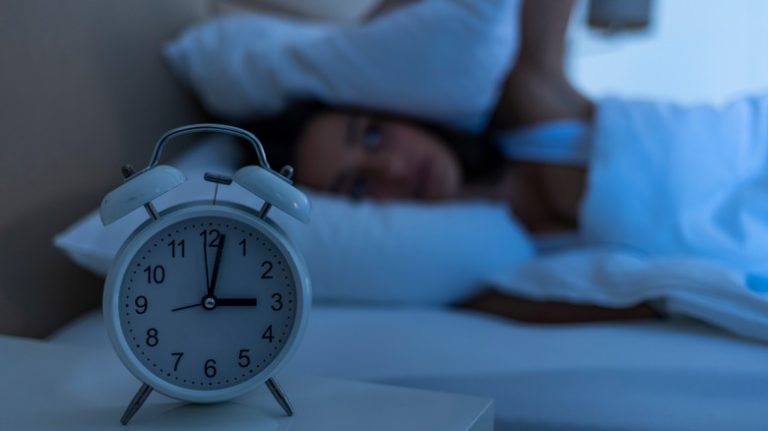If you have sleep apnea – a condition in which your airway gets blocked while you sleep — or have family members who do, you’re probably familiar with continuous positive airway pressure (CPAP) machines, which are one of the most common treatments for sleep apnea (via Cleveland Clinic). While the machines used to be clunky and loud, newer models are smaller, quieter, and much less obtrusive, says the American Academy of Sleep Medicine (AASM). Plus there are a wide variety of brands, models, and accessories to accommodate your specific needs and help you overcome any challenges you may have with CPAP therapy.
The CPAP machine is one of three positive airway pressure devices, says the Cleveland Clinic. As its name implies, the automatic positive airway pressure (APAP) machine automatically adjusts the air pressure to meet your varying needs during the night, while the bi-level positive airway pressure (BiPAP) machine has one pressure setting for inhaling and another for exhaling.
While your CPAP machine is turned on and working properly, the airflow keeps your airway open (via Healthgrades). As soon as you take off the mask or turn off the machine, the airway closes. The CPAP machine is not a cure for sleep apnea, so be sure to use the CPAP every time you sleep — even during naps.
How a CPAP machine works
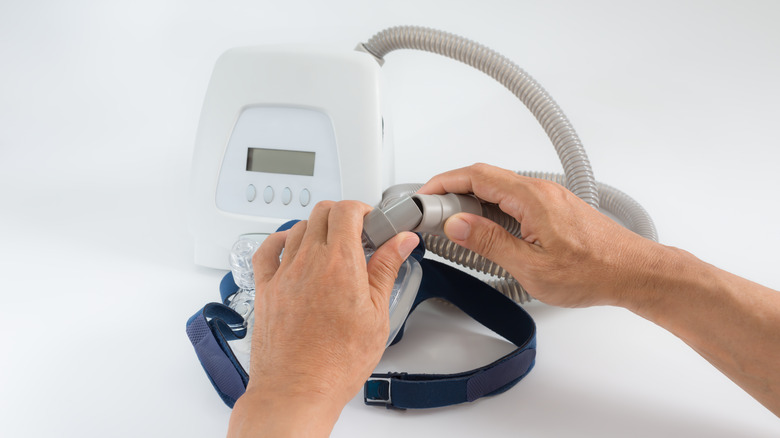
Boiled down to the basics, a CPAP machine consists of a motor, hose, and mask (via American Sleep Association). The motor pulls air from the room and pressurizes it based on the setting your healthcare provider has determined is best for treating your sleep apnea. The pressurized air moves from the machine through the hose, into the mask, then into your mouth or nose. The constant flow of air keeps your upper airway passages open so you can breathe steadily and there’s no interruption of air flow into your lungs.
Of course, it’s never as simple as just choosing three basic components, right? There are reusable or disposable air filters for CPAP machines, hoses that come in a variety of lengths, and heated or insulated hoses. A humidifier comes with some CPAP machines to add moisture to the air flowing into the mask, and is an add-on to other machines. And there are CPAP masks for every face size, sleeping style, air pressure needs, and individual preference (per American Sleep Association).
You need a prescription to get a CPAP machine

You can get a prescription for a CPAP machine from a primary care doctor, nurse practitioner, physicians assistant, dentist, sleep specialist, or psychiatrist (via Aeroflow Sleep), usually after your symptoms are evaluated with a sleep study at home or in a sleep lab. You might also be asked to complete a STOP-Bang Questionnaire, which has been proven to be 93-100% accurate at detecting moderate to severe sleep apnea, according to a study published in Chest. A medical professional can make sure you’re getting the best machine and mask for your needs. They can also help you choose the air pressure setting that will work best for your symptoms.
There are some companies, such as Sleep Care Online, that will handle the whole process virtually — with a home sleep test, an evaluation of the results, and an online prescription. If you purchase a CPAP machine from them, they’ll also help you set up the device and do some troubleshooting, all virtually of course.
A few of the disadvantages of going the online route are that you can’t see how the machine and accessories look, feel, and fit before buying them (via Alaska Sleep Clinic). You can’t be sure the customer service rep is qualified to advise you. And online CPAP suppliers often won’t work with insurance companies, so you’ll probably have to pay for the products yourself.
Things to look for in CPAP machines
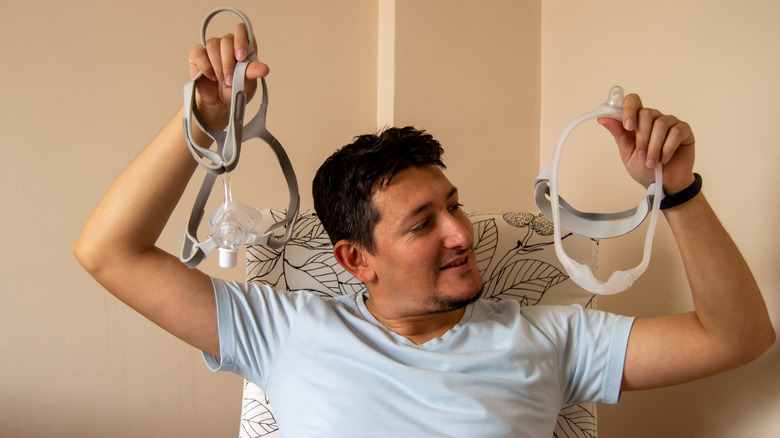
rozdemir/Shutterstock
Top manufacturers of CPAP machines include ResMed, 3B Medical, Fisher & Paykel, Somnetics, Philips Respironics, and Human Design Medical (HDM), says cpap.com. ResMed is one of the most expensive brands, but many consumers consider their products to be worth the price. 3B Medical pegs its sales pitch on offering quality products at a fair price, while Fisher & Paykel’s focus is on machines that are both innovative and easy to use. Check out the CPAP Blog for a brief summary of all the top brands.
If you travel at all, you probably want a lightweight and portable machine you can easily take along when you leave home. A humidifier, which keeps your nasal passages and mouth from drying out, is also an important feature, whether it’s built into the machine or you purchase it as an add-on. And you’ll definitely want to consider how noisy each machine is. A noise rating of 30 dB or lower will be pretty quiet, and a machine rated 25-28 dB will be super quiet.
Air pressure settings and the ramp feature let you adjust the machine’s air flow
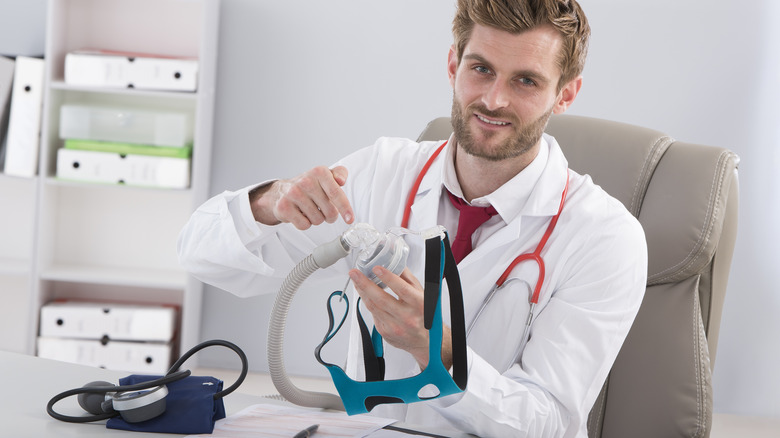
JPC-PROD/Shutterstock
Pressure in a CPAP machine is measured in centimeters of water pressure (cm H20), says the Sleep Foundation. Settings vary based on the device, but most CPAP machines have a pressure range of 4 cm H2O to 20 cm H2O. Some machines go as high as 30 cm H2O, but that is less common.
For those with sleep apnea, the average pressure setting is about 10 cm H2O, and a medical professional will help you determine the correct setting for you. If your CPAP pressure is too low, the air flow won’t be sufficient to keep your airway open through the night. If the pressure is too high, you might experience dryness in your mouth and throat, or a burning feeling in your throat.
There’s also a ramp adjustment on many CPAP machines that lets you start the night at a lower air pressure setting, which makes it easier to fall asleep. Then the pressure gradually increases (via Verywell Health). Some CPAPs adjust automatically to your breathing, increasing or decreasing air pressure through the night as needed, says Consumer Reports. This feature is especially helpful for people who require different air pressure when they’re sleeping on their back versus on their side, or are in one sleep stage versus another, according to Harvard Health Publishing. Changes in your weight may also impact pressure requirements.
Some CPAP machines let you do your own informal sleep studies

Ground Picture/Shutterstock
Many CPAP machines let you record basic information like how long you sleep or how long the machine is in use (via cpap.com). It’s important to remember that the length of time in use is how long you wore the mask, not how long the machine was turned on — just in case you’re tempted to try to trick the recording device.
Other CPAP machines have sophisticated data-recording features that can report the number of partial or total airway collapses you have during the night, leakage rates, pressure changes, and more. Some machines have the ability to send data to a device via Wi-Fi or Bluetooth, and some have a downloadable app so you can easily check on the quality of your sleep and how well the machine is working for you. Do-it-yourself sleep tests are a good way to detect problems so you can discuss them with your healthcare provider.
Why some CPAP machines were recalled in 2024

Hadayeva Sviatlana/Shutterstock
According to the U.S. Food & Drug Administration (FDA), CPAP manufacturer Philips Respironics voluntarily recalled certain CPAP and BiPAP machines and ventilators in June 2024 when it was discovered that the sound- and vibration-limiting polyester-based polyurethane foam in the devices could disintegrate (via Yale Medicine). If that occurred, users could end up breathing or swallowing pieces of black foam or certain chemicals, which could cause serious health problems.
The FDA offers guidelines on how to find out if your CPAP machine has been recalled, and what to do if it has. If you have one of the recalled machines, talk to your healthcare provider about whether you should stop using the device or not. If you have severe, life-threatening sleep apnea, discontinuing use could actually be more hazardous than continuing to use the machine. It could even be fatal.
Exposing your CPAP machine to hot and humid conditions, or cleaning the machine in ways that aren’t recommended by the manufacturer, can contribute to breakdown of the foam.
Cost ranges for CPAP machines and accessories
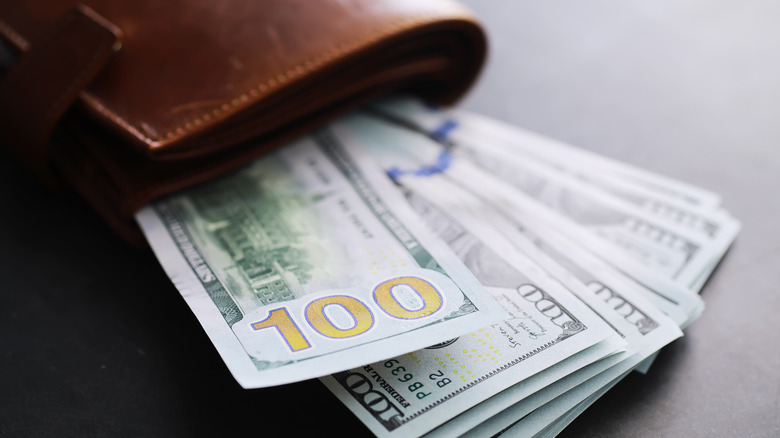
Chatham172/Shutterstock
A CPAP machine itself can cost $500 to $1,000 or more, depending on what type of machine your healthcare provider prescribes (via The Sleep Doctor). On the low end are the most basic models, while the high end includes models with some or all of the latest bells and whistles. Shop around, compare prices, and read online reviews before you buy.
If the CPAP machine includes a mask, great. But often the mask is sold separately, and prices can range from $40 for a nasal mask to $280 for a full face mask, says The Sleep Doctor. Then there are accessories like tubing ($9 to $40), filters ($1 to $25), mask cushions ($14 to $65), and straps ($15 to $40), some of which need to be replaced regularly. And don’t forget cleaning supplies, which may be as simple as detergent and water or as specialized as CPAP cleaning solutions ($5 to $25), mask wipes and disinfectant sprays ($9 to $19), and tube cleaning brushes ($16 to $29).
If the cost of a CPAP machine and all the supplies is keeping you from CPAP treatment, check out the CPAP Assistance Program offered by the American Sleep Apnea Association (ASAA) (via cpap.com). There are also charitable organizations that make gently used CPAP machines available for a small fee. They include the Reggie White Foundation, Second Wind CPAP, and Breathe California for some California residents.
Some children need CPAP machines
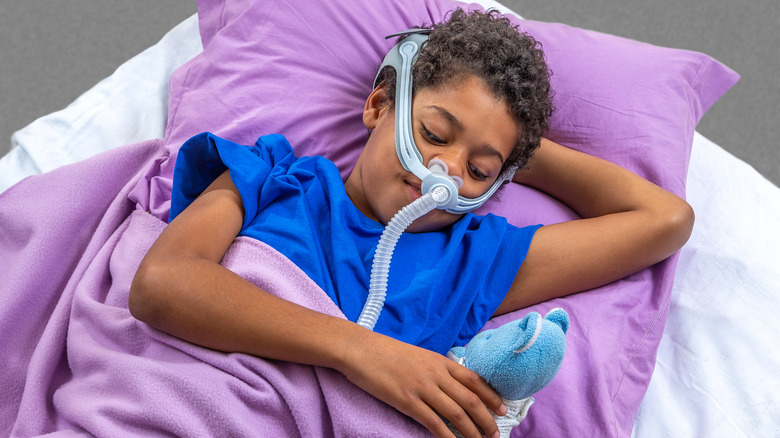
JPC-PROD/Shutterstock
According to a review published in Pediatrics, obstructive sleep apnea (OSA) affects 1-5% of children (via Sleep Foundation), and surgery to remove enlarged tonsils and adenoids is the most common treatment (via Children’s Health). If problems persist after surgery, or if surgery isn’t an option, a CPAP machine may be prescribed. CPAP therapy might also be prescribed while a child is waiting for surgery.
Children — much like adults — often have trouble adjusting to CPAP treatment, and choosing a properly fitting mask that is comfortable, lightweight, and adjustable as your child grows is critical to success (via Sleep Foundation). If your child wears glasses you’ll want a mask that accommodates that, and masks that maximize peripheral vision may help your child feel more comfortable while using the machine. There’s even a mask designed to look like a giraffe!
Children’s Health recommends easing children into CPAP use gently. Talk to your child about how people they admire like scuba divers, firefighters, and astronauts wear masks similar to the CPAP mask. Let them look at and touch the mask before putting it on. Have them practice wearing it for short periods of time during the day while doing something they enjoy like watching a movie or listening to you read a story.
The right mask makes all the difference in your CPAP experience
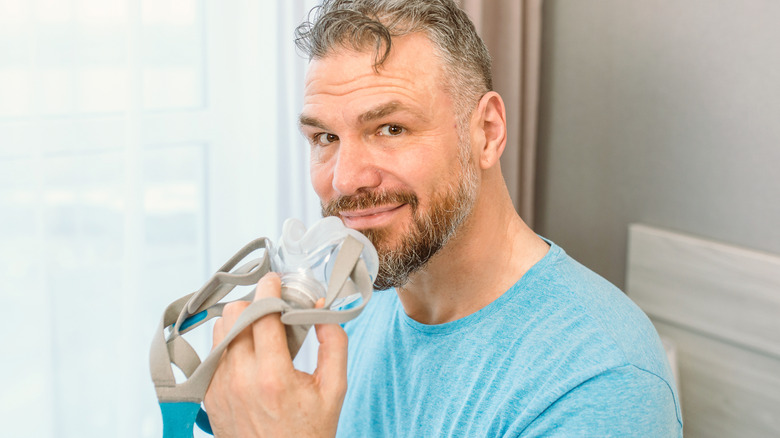
Kateryna Mostova/Shutterstock
The three main types of CPAP masks are nasal pillows, which fit into your nostrils; nasal masks, which cover your nose; and full face masks, which cover your nose and mouth, says the Mayo Clinic.
Your preferred sleeping position is an important consideration in choosing a mask (via Sleep Foundation). For example, if you sleep on your side, the nasal pillow mask is great because it has a relatively low profile and probably won’t make contact with the pillow for your head, an occurrence that tends to break the all-important seal. The nasal pillow mask may also be your best — or possibly your only — option if you sleep on your stomach because of its low profile, but you’ll still need a pillow for your head that doesn’t interfere with the mask’s seal. (Healthline offers recommendations on special CPAP pillows that can help with that). And if you sleep on your back, any of the mask types will work for you.
According to the Mayo Clinic, the nasal pillow mask is a good choice if you get claustrophobic using the other styles, if you have facial hair, or if you wear glasses or want a full field of vision. Nasal masks work well if you need a high air pressure setting or change positions a lot in your sleep. The full face mask is especially good if you breathe through your mouth or have nasal congestion.
Possible causes of a leaking CPAP mask
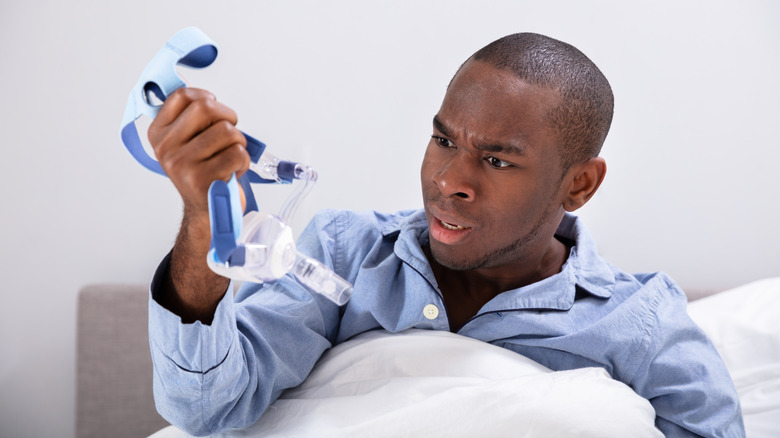
Andrey_Popov/Shutterstock
It’s normal for CPAP masks to leak a little, but a lot of leakage is a sign that you probably have a poorly fitting mask (via cpap.com). Your mask may be too wide or long, allowing air leakage around your eyes or nose. Or you may have the wrong kind of mask for your sleep style, facial structure, facial hair, or the way you breathe when you sleep.
Air leaks might also occur if your mask is past its prime. The silicone cushion in the mask tends to deteriorate with age, so the mask doesn’t hold an effective seal. You may be able to tighten it so it works better, but you can also remove and replace the cushion.
If you sleep on your side, your mask might leak if it’s in contact with your pillow. CPAP pillows are specially designed to minimize that contact, and Medical News Today offers its recommendations for selecting a style to fit your needs.
Side effects of using a CPAP machine and possible solutions
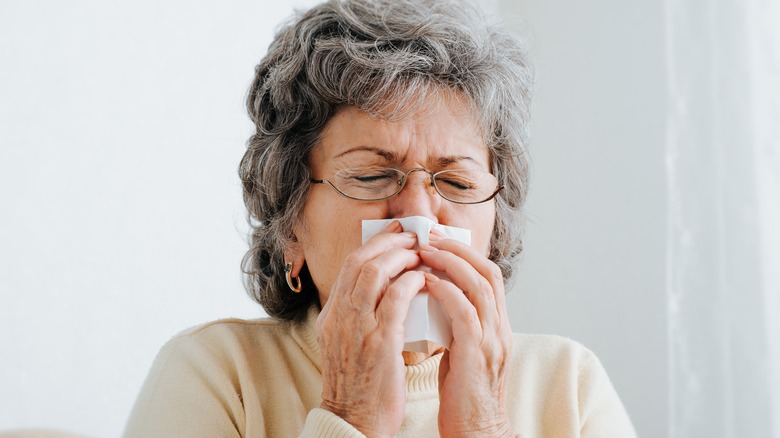
Sergio Photone/Shutterstock
The truth is that getting comfortable using a CPAP machine can be challenging at first, but if you’re willing to be patient and persistent, there are ways to overcome the side effects or problems you may encounter (via Mayo Clinic). If your mask is uncomfortable or leaks, work with your healthcare provider or the CPAP supplier to find a mask that fits your facial features or sleep style better. If you get a dry, stuffy nose, a humidifier could help. And if your mouth gets dry because you breathe through your mouth, a chin strap that keeps your mouth closed should remedy the problem (via Verywell Health).
If you’re bothered by the sensation of the air flow, use the ramp feature on the machine to increase the air pressure gradually while you fall asleep. And if the machine’s sound keeps you awake, check to make sure it is working properly. If it is, you might try wearing ear plugs or using a white noise sound machine to mask the noise.
The pros and cons of getting your health insurer to chip in on your CPAP costs
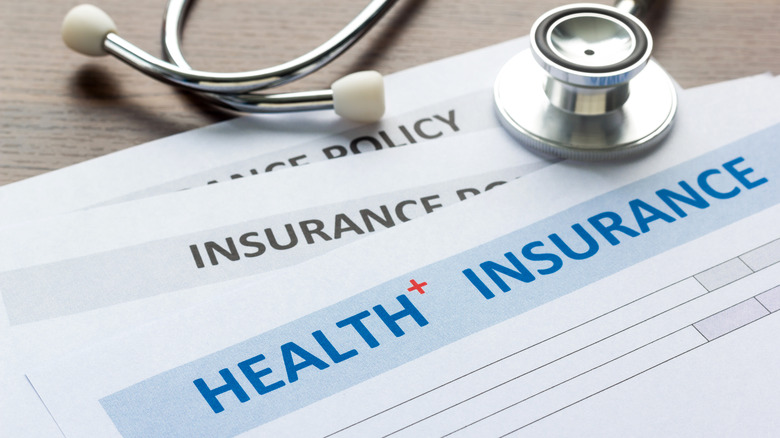
Suphaksorn Thongwongboot/Shutterstock
A CPAP machine is considered durable medical equipment (DME), which means it’s prescribed for everyday or long-term use (via HealthCare.gov). Most healthcare insurers will cover DME costs, says Aeroflow Sleep. It depends on your health plan though, so check your coverage before you count on that. Consider your deductible too. If your health plan has a high deductible, you may be better off paying for the CPAP equipment yourself.
Most insurers will track when, or if, you’re using your CPAP machine — yes, they can do that — and may discontinue your coverage if you’re not using the equipment regularly (via NPR). As an example, the Centers for Medicaid and Medicare (CMS) requires that you use the CPAP machine at least four hours per night on 70% of nights in a consecutive 30-day period (via Sleep Foundation). This makes sense from the insurer’s perspective, considering that a 20-year study published in the Journal of Otolaryngology – Head & Neck Surgery found that less than 35% of people comply with their CPAP treatment plan.
CPAP machines need frequent cleaning
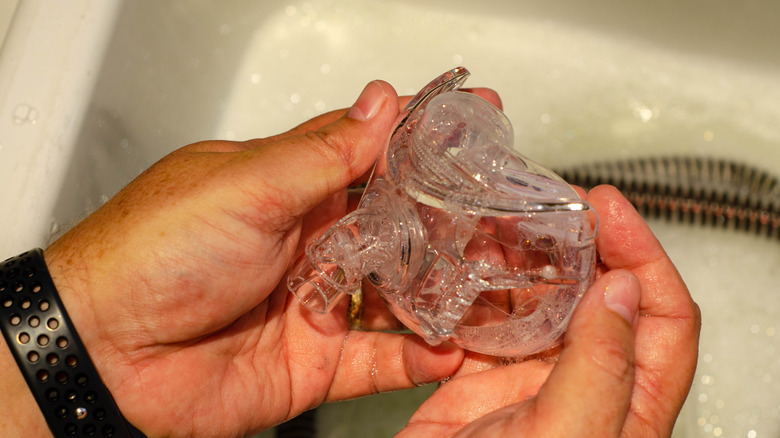
Rick C Lanier/Shutterstock
Bacteria and fungi might proliferate in your CPAP machine, and pollen and dirt can collect in there too (via Medical News Today). Without frequent cleaning, your machine can develop a foul smell, need replacing sooner, and even put you at risk of illnesses.
CPAP machines come with the manufacturer’s directions for cleaning, and you should follow them carefully. According to the American Thoracic Society, you should wipe down the mask or nasal pillows, and empty and refill the humidifier chamber every day. At least once a week you should dismantle the mask headgear and hand wash it — do not put it in the washing machine — as well as cleaning the outside of the CPAP machine and washing and rinsing the tubing. The filter should be replaced once a month if it is disposable
Keeping your CPAP machine clean does take some dedication, which is one reason automatic cleaners are a popular concept. Unfortunately, none of these devices has been approved by the U.S. Food & Drug Administration due to concerns about safety and effectiveness (Medical News Today).
You might love your CPAP right away – or not
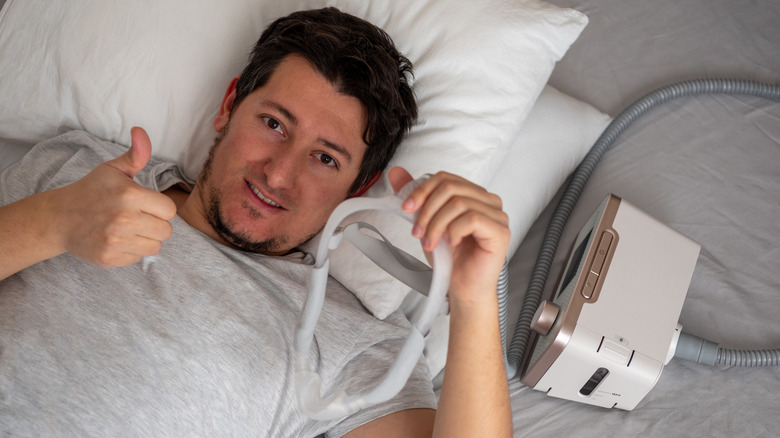
rozdemir/Shutterstock
Your relationship with your CPAP machine may not be love at first sight, but if you approach your new bed partner with a positive attitude and some patience, you may be singing its praises in no time (via Verywell Health). Try looking on it as a friend who’s going to dramatically improve your overall health. Practice getting used to having the mask on your face during the day, and extend the time you wear it gradually. Do something enjoyable while practicing, like watching a movie or listening to music. Then, once you’re reasonably comfortable wearing the mask, hook it up to the tubing and CPAP machine and get used to the feel of the air flow. Start at the lowest air pressure setting and gradually increase it, focusing on breathing deeply and slowly.
If you have problems with the mask leaking or being uncomfortable, getting used to sleeping with the machine whispering beside you, or continuing to feel resistant to the whole concept of CPAP therapy, talk to your healthcare provider or equipment supplier. Getting prompt help can turn your “no way!” into a “I just had my best night’s sleep ever.”



